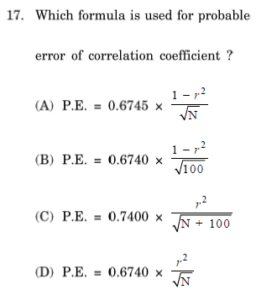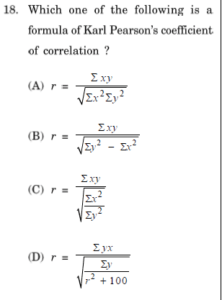- A change in the exchange rate will change the amount of local currency receivable on a bill denominated in a foreign currency. The risk involved is calls:
(a) Import risk
(b) Foreign exchange risk
(c) Transaction risk
(d) Monetary risk - Computer system accessible to non-specialists to assists in planning and decision-making is called_______.
(a) Disk operating system
(b) Expert system
(c) Management information system
(d) Decision support system - Finance commission constituted by the_______.
(a) RBI
(b) SEBI
(c) PNB
(d) President of India - What do you mean by Economic plan?
(a) Gandhian plan
(b) National plan
(c) Five years plan
(d) Year plan - Medium,small and Micro-entrepreneurs contribute about____of the GDP of country.
(a) 8%
(b) 19%
(c) 35%
(d) 40% - The assets are classified as current and fixed assets according to____________.
(a) Accounting period concept
(b) Business entity concept
(c) Going concern concept
(d) Cost concept - For predicting financial distress,the Z-score approach to ratio analysis is developed by____.
(a) J.Betty
(b) Altman
(c) Robert Anthony
(d) Cox - The partner who does not contribute the capital , he is called________.
(a) Sleeping partner
(b) Nominal partner
(c) Secret partner
(d) Partner in profit only - Profit prior to acquisition is credited to____in case of consolidation of financial statement of holding company and its subsidiary company.
(a) Profit and Loss account
(b) Profit and Loss Appropriation
(c) Investment account
(d) Capital reserve account - If profit- volume ratio is 60% for a fixed cost of Rs.3,000 and profit of Rs.3,000, the variable cost should be____.
(a) Rs.3,000
(b) Rs.6,000
(c) Rs.10,000
(d) Rs.4,000 - Rightward shift of demand curve is an example of:
(a) Contraction in demand
(b) Expansion in demand
(c) Increase in demand
(d) Decrease in demand - In the law of variable proportions, when TP is maximum:
(a) MP is rising
(b) MP is falling
(c) MP is horizontal line
(d) MP is ‘0’ - Long run equilibrium under perfect competition is:
(a) Price = AR = MR
(b) TR = TC
(c) MR = MC
(d) Price = AR = MR = AC = MC - Excess capacity exists under market:
(a) Perfect competition
(b) Monopolistic competition
(c) Monopoly
(d) Oligopoly - Marginal product is equal to:
(a) TP – AP = MP
(b) MPn = TPn –TPn-1
(c) MPn = TPn – APn-1
(d) MPn = APn – APn-1 - Which of the following is not the part of the subject matter of business statistic?
(a) Presentation of data
(b) Analysis of data
(c) Interpretation of data
(d) Appointment 

- Statistical hypothesis is the statement_________.
(a) about the parameter
(b) about the data
(c) about the size of sample
(d) about the procedure 
- Which principal of management emphasises replacement of ‘rule of thumb’ method?
(a) Administrative theory
(b) decision theory
(c) Scientific management theory
(d) Contingency theory - In MBO, objects are determined:
(a) Only by subordinate
(b) Only by top level officiers
(c) By subordinate and top level officers
(d) By external agency - The principal of unity of command implies____.
(a) Unity of thought and action
(b) Unity among subordinate
(c) Instructions from staff authority
(d) Instructions from line authority - A formal organisation is one where________.
(a) Authority is formalized
(b) Relationship between people are well defined
(c) At every stage position,responsibility, authority and accountability are clearly defined
(d) Authority and responsibility are equated. - Leadership qualities are inborn. This notion forms part of which of the following?
(a) The follower ship theory of leadership
(b) The behavioral theory o leadership
(c) The path goal theory of leadership
(d) The great men theory of leadership - Which is the first important factor of any marketing mechanism?
(a) Effectiveness
(b) Change
(c) Management
(d) Organization - The exchange value of product is turned as_______.
(a) Value
(b) Price
(c) Money
(d) Cash - The product personality does not include_________-.
(a) Product size
(b) Product price
(c) Product color
(d) Product brand - ______is one of the most popular form of outdoor advertising.
(a) Newspaper
(b) Mail advertising
(c) Posters
(d) Magazine - What is the important objective of marketing research?
(a) To improve the efficiency of marketing system
(b) To accept all risk
(c) To collect different information
(d) To work factually - ______refers to the mix of source from which the long term funds required by a business are raised.
(a) Financial management
(b) Capital management
(c) Captial structure
(d) Finance structure - Low operating leverage and low financial leverage indicates that the company is not utilizing its_____effectively.
(a) Share capital
(b) Debt capital
(c) Retained earning
(d) Fixed assets - A plant would cost Rs. 1,00,000 and would fetch Rs.30,000 in first year, Rs. 30,000 in second year, Rs.40,000 in third year and Rs. 40,000 in fourth year. Hence, pay back period would be:
(a) 3 years
(b) 4 years
(c) 2 years
(d) 1 years - When a company has surplus resources but does not have adequate liquidity then the company capitalizes its reserve and distributes these reserve as:
(a) Equity share
(b) Pref.Share
(c) Bonus
(d) Debt - Assuming that ‘Maxwell Co’ pays a tax at 50%. Compute the after tax cost of capital in case of perpetual bond sold at per,coupon rate of interest being 7%.
(a) 23.5%
(b) 14.5%
(c) 3.5%
(d) 4.17% - Which one of the following is the operational function of HRM?
(a) Organizing
(b) Planning
(c) Compensation
(d) Controlling - Close ended performance appraisal system is used in_______.
(a) Government organisation and public enterprises
(b) Multinational organisations
(c) Private organisations and multinational organisations
(d) Co-operative organisations and private organisations - From the following who did not make any contribution to “Motivation”?
(a) McGregor
(b) McCleland
(c) McFarland
(d) Maslow - The most common activities performed by HR which are outsourced:
(a) Occupational health,payroll,pensions and training
(b) Human resource planning
(c) Recruitment and selection
(d) Assessment centre - Worker’s participation in management means_________.
(a) Duty
(b) Security
(c) Employee involvement
(d) Risk - The interest rate of Reserve Bank of India charged to loans to Commercial banks known as____.
(a) Bank rate
(b) Credit rate
(c) Repo rate
(d) Prime lending rate - The important factor of increasing non-performing assets of Nationalized Banks is______.
(a) Shortage of rain
(b) Political Interference
(c) Indebtedness of farmer
(d) Inefficient management - The main function of national bank for agriculture and rural development is_________.
(a) To promote integrated rural development and secure prosperity of rural area
(b) To provide long term loan
(c) To refinance the rural bank
(d) To act as Apex bank - Which of the following functions is not performed by private banks?
(a) Providing loans to customer
(b) Providing loans to priority sector
(c) Issuing cheque to customer
(d) Recovery of loans - The system which convert financial securities into electronic form is called as_______.
(a) Disinvestment
(b) Re-investment
(c) Re-finance
(d) De-materialization - “Difference in factor endowments explain international trade” This theory is given by:
(a) Leontief
(b) Bertill ohlim
(c) J.S. Mill
(d) Haberler - Balance of trade is equal to:
(a) Total receipt on current account minus total payments on capital account.
(b) Net balance on current account
(c) Net balance of merchandise
(d) Exports of visible s minus imports of invisible s - International finance corporation was establishes in:
(a) July ,1956
(b) November, 1960
(c) March,1947
(d) 1946 - The important function of world trade organization (WTO) is:
(a) To promote international trade and aid among all the countries to promote economic growth
(b) To review and facilitate the coordination of activities of the other institutions,within the U.N.
(c) To provide a machinery for international consultant
(d) To facilitate the implementation and operation of multilateral trade agreement - The trend in composition of India’s exports has been a substantial increase in importance of ______.
(a) Agriculture and allied products
(b) Ores and minerals
(c) Petroleum products
(d) Manufactured goodsAnswer Key
1 (c) 2 (d) 3 (d) 4 (c) 5 (d) 6 (c) 7 (b) 8 (b) 9 (d) 10 (d) 11 (c) 12 (d) 13 (d) 14 (b) 15 (b) 16 (d) 17 (a) 18 (a) 19 (a) 20 (d) 21 (c) 22 (c) 23 (d) 24 (c) 25 (d) 26 (b) 27 (b) 28 (b) 29 (c) 30 (c) 31 (c) 32 (b) 33 (a) 34 (c) 35 (c) 36 (c) 37 (a) 38 (c) 39 (a) 40 (c) 41 (a) 42 (d) 43 (a) 44 (c) 45 (d) 46 (b) 47 (c) 48 (a) 49 (d) 50 (d)
